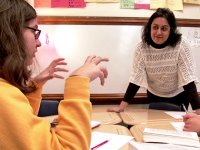4 Things Transformational Teachers Do
Transformational teachers create experiences in their classrooms, melding the art and science of any subject and making their students care about learning.
The key to transformational teaching is not reacting, but rather a grinding obsession with analysis and preparation. Lee Shulman, as reported by Marge Scherer, suggests that expert teachers -- despite enormous challenges --demonstrate:
Cognitive understanding of how students learn; emotional preparation to relate to many students whose varied needs are not always evident; content knowledge from which to draw different ways to present a concept; and, finally, the ability to make teaching decisions quickly and act on them.
So how do they do that? Let's break it down.
1. Transformational Teachers Create Constructivist Experiences
Instructors tend to use one of two instructional orientations:
Transmission: Where "the teacher's role is to prepare and transmit information to learners" and "the learners' role is to receive, store, and act upon this information."
Transformational: Where students' active engagement in developing knowledge and skills, critical thinking, higher-order skills, and communication are facilitated by the instructor.
It is difficult to accomplish transformational teaching without understanding and implementing constructivist pedagogy -- facilitating hands-on experiences --where students construct meaning through active learning. However, the checklist below suggests some tactics:
What Does Transformational Teaching Look Like?
- Have students ask questions and solve real-world problems.
- Questions should require students to: analyze, synthesize, create, empathize, interpret, reference background knowledge, defend alternative perspectives, and determine what they know and don't know.
- Organize students into learning groups.
- Make learning segments manageable through modeling and mastery.
- Guide, facilitate, challenge, and support.
Constructivist teachers focus on enriching students' perspective on the content by facilitating rich experiences. These themes appear in a survey conducted by Grant Wiggins, in which high school students were asked to complete this phrase: "I learn best when the teacher . . ." One adolescent wrote the following:
I learn best when the teacher is hands on and doesn't just talk at me. They need to be interested in what they're teaching and encourage class discussions. Not only does this encourage us to use what we learned, it also helps us see the information in a different way.
2. Transformational Instructors Teach Like Scientists, Artists, and Essayists
Transformational teachers know that artful teaching without science lacks efficacy, and scientific teaching without aesthetics lacks vision. Says child psychologist Dr. David Elkind, "The art comes from the teacher's personality, experience, and talents. The science comes from knowledge of child development and the structure of the curriculum." The art and science of teaching work in harmony. Writes Richard Bankert, an eighth grade science teacher, "The best teachers are artists who know the science of teaching."
In contrast to immature teachers who fill a 90-minute class with activities (and ignore targeted objectives), a transformational teacher treats those 90 minutes like a carefully crafted persuasive essay -- with a clear purpose and unique sense of style, a memorable beginning and end, a logical sequence, important content, nimble transitions, and contagious passion. Together, these characteristics persuade students to believe that learning the content and skills really matters.
3. Transformational Teachers Model Symphonic Thinking
To be effective in advancing human potential, teachers need to manifest what Daniel Pink calls "symphonic thinking" -- critically appraising and synthesizing new ideas. Someone with symphony thinking skills is able to do the following:
- Understand the logical connections between ideas.
- Identify, construct, and evaluate arguments.
- Detect inconsistencies and common mistakes in reasoning.
- Combine different ideas to form a new concept.
- Identify the relevance and importance of ideas.
- Reflect on the justification of one's own beliefs and values.
Nobody said this stuff was easy. But when teachers model symphonic thinking and students internalize it, graduates are better able to thrive in the new economy, according to Pink.
4. Transformational Teachers Facilitate Productive Struggle
It's hard not to rescue kids when they beg for help. But an instructor's altruistic instinct can get in the way of learning. In a Wired magazine piece, "Telling You the Answer Isn't the Answer," Rhett Allain explains why letting students engage in productive struggle is the unpopular and necessary approach to instruction:
What if a person was having trouble doing a pull up for exercise? Instead of giving them some other exercise, I could help them by doing the pull up for that person. Right? No, that wouldn’t actually be useful. However, if I push on the person's feet a little bit, they can still struggle and still exercise.
Warning: allowing productive struggle to occur consumes more class time. But retention is undermined when learning is frictionless. Purposeful struggle today means less re-teaching tomorrow.
Allowing productive struggle to occur, using artistic and scientific instruction, modeling symphonic thinking, and encouraging students to lean into constructivist problem solving can lead to the holy grail of transformational teaching: epiphany.
